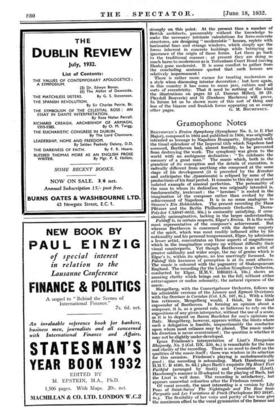The Modern Home
The Studio Year Book, ONE always opens a new Studio Year Books with keen anticipation. It forms an excellent survey of the yea:r1; i Work in almost every form of decorative art from archi- tecture to ceramics and textiles. Looking through its admirable Blustrations, one 'can see in what direction's progress has been made, which tendencies have groin stronger and which are dying down. This year the MO- trations are no less interesting than usual, apart from an apparent disinclination to show the more progressive examples of British architecture (I can think of at least two houlies which might have been given space ; and a round dozen or two of those depicted could have been spared, for any interest or originality that they- show). But with the brief editorial matter there is graver fault to be found. I quote from the preface, " Recent Domestic Architecture " " The modernist' house . . - remains an interesting idea ; but for one reason or another has not yet advanced to the poitit of being widely used or of presenting the economic, advantages which ought to be one of its main claims for consideration. The examples hero illustrated show the striking effect produced by these houses, and something also of the lightness and airiness which pervade them. Two cardinal defects in concrete cod- struotion nevertheless remain. The first is that in certain localities it does not harmonize with the landscape as the house built with local materials always. (sir) manages to do. The‘second is that it cannot be altered or modified after it has been built. On the other hand, the modernist' style is adaptable to other material); than concrete, as experiments in England have shown. And fair purposes where too greet a degree of permanence is not requiZefl it should be economic.
For sheer wrongness of facts and of thinking the foregoing sentences would be hard to beat. Let us take the facts first. Economically the truly modern house offers advantages unapproachable by any other type. The foot cube price for a medium-sized house, ready for the owner and his furniture, is as low as Is. 5d. ; and this figure includes central heating, first-class light and sanitary fittings, and such luxuries as a £60 cooker and all walls and ceilidge enamelled. -For such purposes as slum-clearance schemes the price can be reduced by twopence or more. Ne3di, harmony with surroundings. The modern house can be designed to harmonize with its surroundings just as via as any other house. The Dutch, who have assimilated the modern idiom more completely, pekhaps, than ,any othch people, face many of their modern buildings' with thin brick- Work, and the result is beautiful and entirely harmonious-- Concrete can be finished in any colour and to almost any texture—if imitation thatch is not insisted upon. As to shape, nothing would strike the cave -man as more incon- gruous than the Gothic spire, which use has made us feel an almost integral part of the English countryside. Familiarity will deal in the same way with the modern house. Finally, can the concrete house be altered and modified ? It can. Short of tampering with the actual structure, partition-walls ran be more easily moved than in other types, doors and windows can be pierced, new wings can be added. .So much for the facts.
The wrong thinking is betrayed by the sentence : " The ` modernist ' style is adaptable to other materials than concrete," &c. Modernism in architecture is not a style at all : it is a method of building. I cannot insist too - * TM-audio -Year-Book-4 Decorative Art, 1982;
strongly on this point. At the present time a number of British architects, presumably without the knowledge to make the necessary intricate calculations for ferro-concrete structures, are designing " modernistic " houses, replete with horizontal lines and strange windows, which simply ape the forms inherent in concrete buildings while betraying an ignorance of the origin of those forms. Let them go back to the traditional manner : at present they are doing as much harm to modernism as is Tottenham Court Road (saving Heals) gone modernist. It is some comfort to gather from the concluding sentence quoted that such houses are relatively impermanent -
There is rather more excuse for treating modernism as a style when discussing interior decoration ; but here again, in this country it has come to mean jazz, cubism and all sorts of eccentricity. That it need be nothing of the kind the illustrations on pages 85 (J. Duncan Miller), 39 P. Pleydell Bouverie) and 51 (Denham Maclaren) will prove. In future let us be shown more of this sort of thing and less of the bizarre and freakish forms appearing on so many









































 Previous page
Previous page